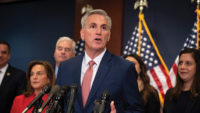When Congress returns after Labor Day from its break, lawmakers will be staring at deadlines just weeks ahead for at least three must-pass, construction-related measures. The list includes legislation to fund federal agencies for at least part of fiscal year 2018 and a measure to reauthorize Federal Aviation Administration programs, including airport construction grants. The deadline for both bills is Sept. 30. Congress has made headway on the measures but almost certainly won’t have final votes by the deadline. That means lawmakers will turn to stopgap extensions.
In addition, Congress soon must raise the $19.8-trillion federal debt limit to avert a government default. The Congressional Budget Office in a June 29 report said “the Treasury will most likely run out of cash in early to mid-October.”
Looking at the near-term legislative agenda, Steve Hall, American Council of Engineering Companies vice president for government affairs, says, “A lot has been packed into the fall, and it’s going to be a challenge. But [they are] necessary actions that have to get done.”
Multiyear FAA bills have cleared committee in the House and Senate. The House committee’s six-year version averages $3.62 billion a year for airport grants; the Senate panel’s four-year bill averages $3.65 billion annually. This year’s appropriation is $3.35 billion.
But getting a final measure enacted by Sept. 30 is an extremely long shot. A big sticking point is a proposal drawn up by House Transportation and Infrastructure Committee Chairman Bill Shuster (R-Pa.) to spin off FAA’s air-traffic-control operations into a new non-federal organization. It’s in the FAA bill his panel approved but not in the Senate committee’s version; there is opposition among appropriators, too. “It sure feels like they’re going to need an [FAA] extension,” says Jeff Shoaf, Associated General Contractors of America senior executive director for government affairs. “Shuster’s not willing to give up on what he wants to do, but he doesn’t have the votes to get it out of the House yet, let alone get through the Senate.”
By the August recess, the House had approved four of the 12 fiscal 2018 appropriations bills that each fund one or more agencies: defense, military construction and veterans affairs, energy and water programs, and the legislative branch. Eight other bills have cleared committee. The full Senate has yet to vote on any of the 2018 spending measures, but its Appropriations Committee has approved six of the 12 spending bills. Those results don’t bode well for having new full-year appropriations measures on the books by Oct. 1, when fiscal 2018 begins. “We need more progress on appropriations bills,” says Hall. For the engineering and construction industry, “that whole effort is a huge, huge priority,” he says.
Shoaf observes that increasing the debt limit is another top item on Capitol Hill. “I know that it’s a priority to get that done in September,” he says. “Democrats and most folks in the administration want it just to be passed cleanly”—that is, without any accompanying spending reductions.
Beyond the must-pass short list, industry officials also hope to see more details after Labor Day from the Trump administration about its tax-reform and infrastructure investment plans. Transportation Secretary Elaine Chao has said additional information is expected to be released on the $1-trillion, 10-year infrastructure proposal this fall.




Post a comment to this article
Report Abusive Comment